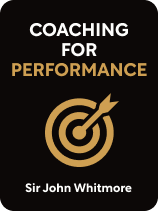

This article is an excerpt from the Shortform book guide to "Coaching for Performance" by Sir John Whitmore. Shortform has the world's best summaries and analyses of books you should be reading.
Like this article? Sign up for a free trial here.
Want an overview of Coaching for Performance by Sir John Whitmore? What does a performance coach do?
In Coaching for Performance, Sir John Whitmore explores the ins and outs of performance coaching in business, the coaching session structure, and ways to measure organizational culture. The book models the “we’re in it together” mindset to show how leaders can maximize coachees’ performance.
Read on for an overview of the main advice in Coaching for Performance by Sir John Whitmore.
Coaching for Performance by Sir John Whitmore
The main lessons taught in Coaching for Performance by Sir John Whitmore are how to hone leaders’ skills, maximize employees’ potential, and drive performance through coaching. In a work world forever changed by globalization and the ability to exchange information instantly, leaders must shift from a command-and-control management model to a “we’re in it together” mindset that recognizes workers’ value. Performance coaches help leaders step into this new reality by revealing and capitalizing on employees’ greatest talents.
(Shortform note: In this article, we’ll refer to “you” as the coach. We’ll also follow Whitmore’s lead of using “coach” to refer to internal and external coaches (those employed and contracted by the company) as well as leaders, whose roles require coaching. This article will focus predominantly on 1:1 workplace coaching, which centers on maximizing the performance of employees (“coachees”) and leaders.)
Whitmore is a pioneer of workplace coaching and co-creator of the popular GROW model, a coaching framework for goal setting and performance improvement. The International Coach Federation gave him the President’s Award in 2007 to honor his lifetime of work. Published in 2017, the 5th edition of Whitmore’s groundbreaking 1992 book offers updated information on the benefits of coaching and giving feedback as well as new ways to assess and measure organizational culture and performance.
What Performance Coaching Is and Isn’t
In Coaching for Performance by Sir John Whitmore, performance coaching is described as a strengths-based, non-judgemental partnership in which coaches help business leaders and workers develop goals, strategies, and skills to maximize their potential and drive performance. Performance coaches should view their coachee as fully capable, resourceful, and proficient in their thoughts, abilities, and skills—the coach’s role is simply to reveal their best.
Whitmore says a performance coach’s job is not to instruct employees on how or what to do, which can rob your coachee of the chance to absorb information they need to develop self-confidence, autonomy, and ownership of their work.
Whitmore’s belief that a coach’s role is to help workers maximize their potential is rooted in psychologist Abraham Maslow’s hierarchy of needs. Maslow believed that all humans have the same basic needs and must satisfy each level of need to fulfill their greatest potential: self-actualization. His hierarchy is illustrated as a pyramid with five horizontal layers:
- At the bottom of the hierarchy are basic survival needs like food, water, and shelter.
- Once you satisfy these needs, you strive to meet mid-level needs for love, belonging, and esteem, respectively.
- Upon satisfying these needs, you aim to satisfy your final need: to self-actualize. You satisfy this need when you find purpose and fulfill your potential.
At this point, you feel capable of functioning independently, believe that others respect your ability to do so, and don’t feel the need to prove your worthiness to anyone. Whitmore says performance coaches should strive to help coachees reach this point.
The Benefits of Performance Coaching
Whitmore says there are numerous benefits of performance coaching, including these four:
1. It maximizes employee and company performance. The process taps workers’ and teams’ potential and fosters learning cultures that encourage risk-taking and innovation.
2. It improves job satisfaction, engagement, and retention. When coaches ask employees questions and show interest in them, workers feel valued. Workers who feel their voices matter are more satisfied, engaged, and likely to stay at their job
3. Coaching reveals information that helps companies succeed. When leaders meaningfully engage workers, including through coaching, employees are more inclined to share vital, on-the-ground information that can inform organizational decisions. This fosters a worker-centered culture that sees staff as integral to the company’s problem-solving processes.
4. Coaching balances responsibility evenly across companies. Coaching strengthens employees’ capacities and confidence and encourages them to take ownership of their work. When workers function autonomously, leaders can focus on big-picture issues, not minutiae.
Create a Coaching Session Structure
In the last section you learned what performance coaching is and what some of its benefits are. Now we’ll look at how to effectively coach for performance, starting with how to structure sessions so you can make the most of your time with your coachee.
Structure Your Sessions
Whitmore says that whether you work within an organization or have been contracted to provide performance coaching services, you can maximize sessions’ effectiveness by putting a clear structure in place before you begin. This structure should include:
1. The time frame over which coaching will take place. Whitmore recommends a six-month duration, which gives your coachee time to practice building new habits and develop a good working relationship with you.
2. The preferred format and number of hours per session. This will vary depending on whether your coachee’s company wants you to conduct sessions in person, virtually, or using a combination of the two. Typical sessions last 60 minutes.
3. A consultation meeting with your prospective coachee. The purpose of this meeting is to ensure that you and your coachee are a good match for work together.
4. A follow-up meeting to set expectations. Once you’ve agreed to work together, meet with your coachee to discuss logistics, the nature of your work, and your respective wants.
Coach to Maximize Potential and Performance
In the last section we discussed how to structure performance coaching sessions from the outset to make the most of them. Now we’ll look at three steps to build trust with, empower, and make the most of your coachee’s potential and performance, according to Sir John Whitmore’s Coaching for Performance.
Step 1: Build Trust and Connect
Whitmore says you have to build trust and connect with your coachee so they’ll open up and engage fully in the coaching process, which will help you maximize their potential. To do this, listen actively to show that you care and be aware of your own thoughts and feelings so they don’t interfere with your work.
Listen Actively: When you listen carefully to your coachee, you show that you care about them, making it more likely that they’ll share information that will help you maximize their potential.
Be Aware of Your Thoughts and Feelings: Whitmore says you should monitor your thoughts and emotions before and during sessions to connect with your coachee in an unbiased manner. Failure to let go of negative ideas and judgments about your coachee can damage your perception of them as a partner.
Step 2: Empower Your Coachee
According to Sir John Whitmore’s Coaching for Performance, to maximize your coachee’s potential, you must nurture three qualities: Self-confidence, awareness of self and others, and ownership of their work.
Build Self-Confidence: Whitmore says that when you foster your coachee’s belief in themself, they function at their peak. Coaching naturally cultivates a positive cycle of self-belief in the following way: Coachees set and achieve small goals in pursuit of a larger end goal, creating a series of successes that they attribute to their efforts. This builds their confidence in what they’re doing and encourages them to continue forward on a positive path.
Build Attunement to Self and Others: Whitmore suggests you help your coachee become attuned to—or aware of—their own and others’ feelings and situations to maximize their potential. Self-attunement helps your coachee consider their emotions and biases so they can make conscious decisions about how to act—and avoid reacting—in the heat of the moment. This self-regulation supports their ability to act in ways that foster healthy working relationships.
Build Accountability and Ownership: Whitmore says coaches should help coachees develop an accountability and ownership mindset to increase their commitment to their work and maximize their potential. When workers feel they have ownership of their goals and can decide the best way to accomplish them, they’re motivated to do their best, which improves their performance.
Step 3: Set and Achieve Goals With the GROW Model
Whitmore says you can help your coachee illuminate and achieve goals using the GROW model—a framework he and colleagues developed in the late 1980s to help employees set goals, maximize their potential, and improve performance. The model has four stages:
- Goal Setting. Identify your coachee’s immediate and end goals.
- Reality. Assess whether your coachee has chosen a realistic goal.
- Options. Explore all possible actions the coachee could take to achieve their goal.
- Will. Determine your coachee’s determination to follow through on their goal by outlining specific steps, timeframes, and accountability frameworks for accomplishing it.
(Shortform note: The CLEAR coaching model preceded Sir John Whitmore’s GROW model in Coaching for Performance and rests on the idea that managers should develop and guide workers—not just give directives. GROW takes the idea a step further, saying that managers and leaders should maximize employees’ potential by giving them ownership of their work. Another difference between the models: CLEAR focuses on coachees’ motivation and behavior, while GROW centers more on goal setting, making action plans, and reviewing goals. CLEAR stands for Contract (define your coachee’s work), Listen to your coachee’s feelings, Explore your coachee’s beliefs and assumptions, Action (make a plan), and Review your coachee’s progress.)
Measure Organizational Culture and Performance
You just learned how to build trust with, empower, and help your coachee set and achieve goals to maximize their performance. In this final section, we’ll discuss how to assess organizational culture and measure the impact of your coaching.
Measure Culture and Performance
Whitmore says that to drive performance, leaders must understand their organization’s culture and its impact on performance and, as the performance coach, you must understand the impact of your work on company performance. Whitmore’s Performance Curve enables assessment of the former, and his Return on Investment (ROI) methodology measures the latter.
The Performance Curve: The Performance Curve outlines four stages of organizations’ cultural development and corresponding levels of performance that coaches and leaders should assess. Workers’ motivating force at each stage in the Performance Curve corresponds to the needs that drive people at each level on Maslow’s hierarchy of needs.
Measure the Return on Investment of Your Performance Coaching: Whitmore’s ROI measures the effectiveness of your performance coaching work at maximizing coachees’ potential and performance and changing organizational culture. This allows you to see the effectiveness and benefits of your performance coaching.

———End of Preview———
Like what you just read? Read the rest of the world's best book summary and analysis of Sir John Whitmore's "Coaching for Performance" at Shortform.
Here's what you'll find in our full Coaching for Performance summary:
- A guide on the ins and outs of performance coaching
- Strategies to maximize employees’ potential and performance
- How to measure organizational culture and the impact of your work






